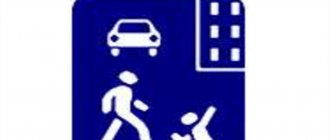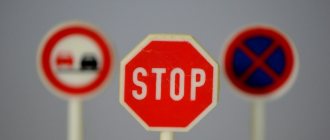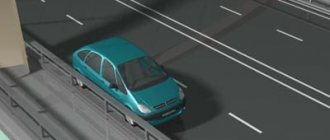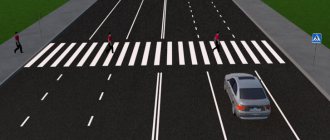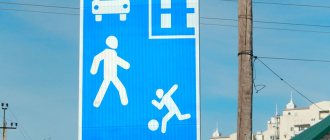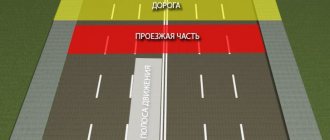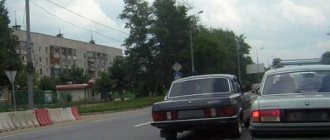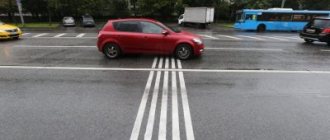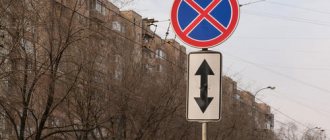A pedestrian zone sign marks a separate area in order to ensure the safe movement of pedestrians. It is often confused with other similar designations, which leads to violation of traffic rules. Drivers risk running into a fine of 500 rubles, since the movement of any type of transport in the area of the sign without additional signs is strictly prohibited. But there is also a sign “Pedestrian traffic is prohibited.”
From the article you can find out how the zone is designated and how it differs from a pedestrian path. It is described when the ban on placing vehicles in a zone does not apply and whether it is possible to drive without violations to the territory where the sign is in force. Various options for recording violations and answers to readers’ questions on the topic are also provided.
Purpose and coverage area of sign 5.33 “Pedestrian zone”
Mandatory pedestrian zone sign. It establishes a special regime, mandatory for all citizens in the area designated by it.
The term is defined by clause 1.2 of the Rules. They designate the territory in a populated area where citizens have the right to move exclusively on foot.
Such a zone begins with road sign 5.33. To determine the end of the pedestrian zone, sign 5.34 is used.
The first is presented in the form of a rectangular plate, in the middle of which there is a circle with a blue background. It depicts the silhouette of a person. At the top above the circle is the inscription “Zone”. Most often, an additional image of a red “snowflake” is placed.
The city usually adds 8.5 signs. They determine the duration of the sign - a clear time period, a specific day or month.
What are they needed for
The concept of the adjacent territory to a private house behind the fence, how many meters
As the practice of large cities shows, the number of vehicles is growing every year, as a result of which traffic jams are increasing. The main way to combat them is through paid parking, and in some European cities, paid entry into the city or into the city center. In order to remove all gas pollution and the release of harmful substances into the air, traffic is closed to cars.
In some cases, the allocation of a pedestrian zone is also associated with attractions located in the city. For example, in Moscow the main pedestrian area is Arbat; other regions also have their own separate small parts of streets. If we take Europe, then not only have entrance fees been introduced in many cities, but entire streets have been allocated for pedestrians.
Each of these pedestrian zones must be marked on all sides with appropriate signs 5.33 and 5.34.
Differences between the “Pedestrian zone” and the “Pedestrian path”
Externally, the signs are quite similar and, moreover, both impose a ban on traffic within their range.
However, there are differences between them:
- A pedestrian path is created intentionally for pedestrians, planning it in advance. Whereas a zone is a modified territory adapted for pedestrians, which can be a section of a road. This includes both curbs and adjacent sidewalks. Indicated by the sign “Pedestrian path”.
- Despite the fact that vehicles are prohibited from moving along the path for pedestrians, exceptions are provided. Thus, the established rule can be legally violated by municipal and road maintenance structures if it is necessary to carry out certain work with the participation of special vehicles. In addition, vehicle access is permitted if it is related to loading and unloading of goods, but provided there is no alternative route. As for driving through the pedestrian zone, there is a mandatory rule. If there are no additional signs establishing the expiration period of the sign, vehicles, including mechanical ones, must not violate the restrictions.
- The path for citizens traveling on foot is marked with only one sign at the beginning of the action - 5.4. It ends when it intersects with any road. In turn, two separate signs are provided to mark the beginning and end of the pedestrian zone.
PEDESTRIAN AREAS OF CITIES
In the middle of the 20th century. The concept of “pedestrian zone” entered the urban planning practice of European cities. The main type of such zones is a shopping street. It is practically an open passage with many shops and cafes. Pedestrian zones may include areas adjacent to entertainment and entertainment venues, for example, theaters, art galleries, exhibition complexes, and vernissages. The entire surrounding space, as a rule, the center of a district or city, is extremely saturated with trade objects, museums, and all kinds of entertainment to attract large flows of people.
Pedestrian areas should be beautifully and comfortably decorated, landscaped, and landscaped; this makes the city more attractive and convenient for living. An example is the pedestrian zones created in Moscow such as Arbat and Nikolskaya streets, Manezhnaya Square, Stoleshnikov, Kamergersky, Lavrushinsky lanes. They were formed by closing streets in the historical part of the city to vehicles. When creating all Moscow pedestrian zones, city planners solved an individual problem, taking into account the historical and thematic features of the place and the needs of various population groups. This was taken into account during the reconstruction and was reflected in the architectural design of the named pedestrian zones, each of which received an individual thematic focus when saturated with urban infrastructure objects. The Moscow experience is of particular interest in this sense, since it is rare in world practice. Among the pedestrian zones of European cities, only Montmartre and the Latin Quarter in Paris stand out for their theme.
When drawing up reconstruction projects that create pedestrian zones, situational statistical surveys of intended visitors are carried out. Possible groups of the population are identified for which this pedestrian zone will become an attractive form of recreation, a point of attraction. Such visitors can be visitors, tourists, young people, elderly people, parents with children, or simply transit pedestrians. Designers take into account the needs of all such groups and intended visitors and create appropriate conditions for ease of use, including in the surrounding buildings.
A historically formed city with a long-established single dense and extensive system of transport and pedestrian connections requires a particularly careful approach to changing them. The creation of pedestrian zones requires careful preparation and thoughtfulness of their location, routing, and orientation towards the interests of a particular group of pedestrians
Pedestrian spaces create the opportunity for recreation, while providing convenient places for access and parking of cars, and the proximity of surface or underground public transport stops. The external attractiveness of objects restored during the reconstruction process, which receive a new purpose, is especially important. Pedestrian zones should not interfere with the passage of public transport. Their detour is organized along a parallel or ring highway.
Penalty for driving in a pedestrian zone
If traffic regulations are not followed and sign restrictions are ignored, the culprit faces administrative liability.
It would be a mistake to assume that the violation will be qualified under Part 12.15 of the Administrative Code. This article does not indicate the pedestrian zone and the corresponding restrictions.
Attention should be paid to Article 12.16 of the Administrative Code. The punishment for it is less.
The article punishes drivers who do not comply with the requirements established by road signs.
There are several sanctions. The least involves only warning the violator. More severe - a fine for driving within the limits of the sign. The driver will have to pay 500 rubles for inattention. The difference is noticeable, because in the first case a fine of 1.5 thousand rubles is expected. more.
Drivers should be aware of this feature, since inspectors can take advantage of drivers’ ignorance of the nuances of traffic rules.
Penalties for violations of the boundaries of the territory for pedestrians
The current Code of the Russian Federation on Administrative Offenses does not contain a rule that would directly provide for administrative liability for violation of the requirements of sign 5.33. Part 2 of Article 12.15 of the said legal act provides for penalties in the amount of 2,000 rubles for those drivers who drove a vehicle on pedestrian paths or sidewalks.
However, as you can see, the indicated norm does not specifically refer to the pedestrian zone, so it is not applicable for those motorists who entered the pedestrian zone. This means that the driver can be prosecuted for committing such an offense only under the general norm of Part 1 of the following article of the Code of Administrative Offenses - 12.16. The sanction of the article involves a warning or a fine, the amount of which is 500 rubles; and it is imposed in all cases of violation of the requirements of road signs and markings, unless they are stipulated by special rules.
A paradoxical situation arises when driving in a pedestrian zone is “more profitable” than driving onto the sidewalk, although the social danger of both acts is approximately the same. Perhaps, over time, this imbalance of liability measures will be eliminated, but in 2021, the driver will be punished for driving a car in a pedestrian zone precisely under Article 12.16, which implies a more lenient sanction.
Who is allowed to move in the area covered by sign 5.33
If the “Pedestrian zone” sign is used without additions to it, there is a complete restriction of the movement of any type of transport on the territory. You can only move within the sign's coverage area on foot. Any violations entail liability.
When it is necessary to free part of the city from traffic at a certain time, this sign is temporarily installed.
If signs 8.5 are used with a sign, it prohibits vehicles from moving through the territory only at certain times.
For example, a red o at the bottom of the sign means that restrictive measures are in effect only on weekends and holidays.
During other periods not covered by additional marks, movement is permitted.
The only amendment concerns tram and pedestrian streets. If such a sign is installed on them, trams, in addition to pedestrians, can move along the street.
Traffic in residential areas
The road, what is it according to traffic regulations, definition and composition
In the Rules, the term “Residential zone” is given a broader meaning than in urban planning practice or everyday life. This can be not only the territories of the so-called urban “dormitory” areas, but also individual streets (or sections of streets) in the business and commercial part of the city, where it is necessary to provide more favorable conditions for pedestrians, without prohibiting the movement of vehicles altogether.
There is an opinion among drivers that the rules of movement in residential areas apply only when there is a corresponding sign at the entrance to such an area - a schematic image of a house and people on a blue background (clauses 5.21 and 5.22 of the traffic rules). In fact, the rules must be followed in all internal passages and courtyards. The easiest way to distinguish a residential area from a small street or alley is by toponymy - internal passages do not have official names.
In addition, through traffic is prohibited in courtyards (although motorists like to avoid traffic jams in courtyards), practice driving, and parking with the engine running (more than 5 minutes). However, in cold weather, drivers are tacitly allowed to deviate from the parking requirement if it is necessary to warm up the engine and clear the snow from the car. Well, drivers of heavy vehicles with a curb weight of more than 3.5 tons do not have the right to park their vehicles in courtyards and residential areas.
How is an offense recorded?
Employees of the State Traffic Inspectorate and the patrol service can record a violation. Violations are often recorded using automated cameras.
However, recently, notifications from law-abiding citizens have increasingly become the reason for considering cases of administrative violations.
Any citizen, whether a pedestrian or a driver, has the right to record a violation of the Rules himself if he has become an involuntary witness. Usually photo or video recording is used. The materials are handed over to law enforcement officers.
You can contact the inspectorate in person, send an application by mail or online.
The popularity of using a special application on mobile devices is also increasing. The program's functions allow you to record evidence with a guarantee of its originality, report information about the citizen who committed the violation, and even receive bonuses.
